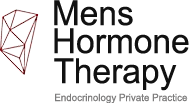Testosterone (T) is the main men sex hormone produced by the testis (testicles) in men and by the ovaries, although in much smaller quantities, in women. T not only determines if a fetus is going to be boy or girl but it is also the hormone which turns a boy into a man during puberty.
To this regard, T initiates the development of the male internal and external reproductive organs during foetal development and is essential for the production of sperm in adult life. During childhood the levels of T are very low and it is the surge of T which initiates puberty in boys. These high levels of T during puberty are responsible for:
- Growth of the penis, testes and prostate gland
- Growth of facial, pubic and body hair
- Deepening of the voice
- Building muscles and strong bones
- Less body fat compared to women
- Getting taller
- Sexual and aggressive behaviour
Secretion of Testosterone
It is first the gonadotropin releasing hormone which is secreted in a pulsating manner from the hypothalamus, a brain structure close to pituitary glands. This elicits pulsatile secretion of luteinising hormone and follicle stimulating hormone by the anterior pituitary. These two pituitary hormones in turn interact with testis to stimulate T and sperm production.
Ageing is associated with a progressive decline of daily T secretion rates and thus reduced T blood levels. Both reduced secretory capacity of testicles but mainly, reduced stimulation from the hypothalamus and or pituitary of testis appear to be responsible for the low levels of T with age.
Severe T deficiency as occurs in hypogonadism of young or middle aged men, results in loss of libido, erectile dysfunction, decreased perceived quality of life and sense of well-being. Furthermore, increased percentage body fat, reduced muscle mass, impaired muscle function and an increased risk of cardiovascular diseases were all common findings of men with low T levels.
Epidemiology of declining androgen levels in elderly men
Testosterone and bioavailable T levels have been shown to decline with ageing in several studies. Subsequently, in several long-term studies, it has been shown that the total T declines 1% each year. Even higher rates of decline is recorded when free T, which is the biological active testosterone, is measured.
To this regard, 20% of men over 60 and 30% of men over 70 have testosterone levels lower than the physiological normal range. Furthermore, almost 60% of men over 70 years of age have lower than normal free T levels.
Testosterone replacement therapy
Testosterone replacement therapy in men has consistently been shown to increase muscle and bone mass and reduce body fat. Additionally, sexual function, mood and quality of life remarkable improve after testosterone replacement therapy in men with low T levels.
When however, we combine growth hormone with testosterone in suitable individuals, it appears that it preferentially affects skeletal muscle mass and indeed, physical performance and exercise capacity change for the better
